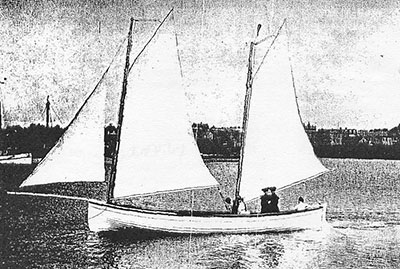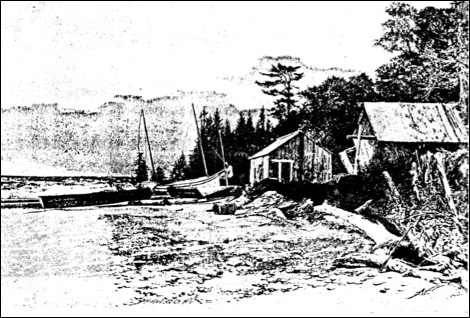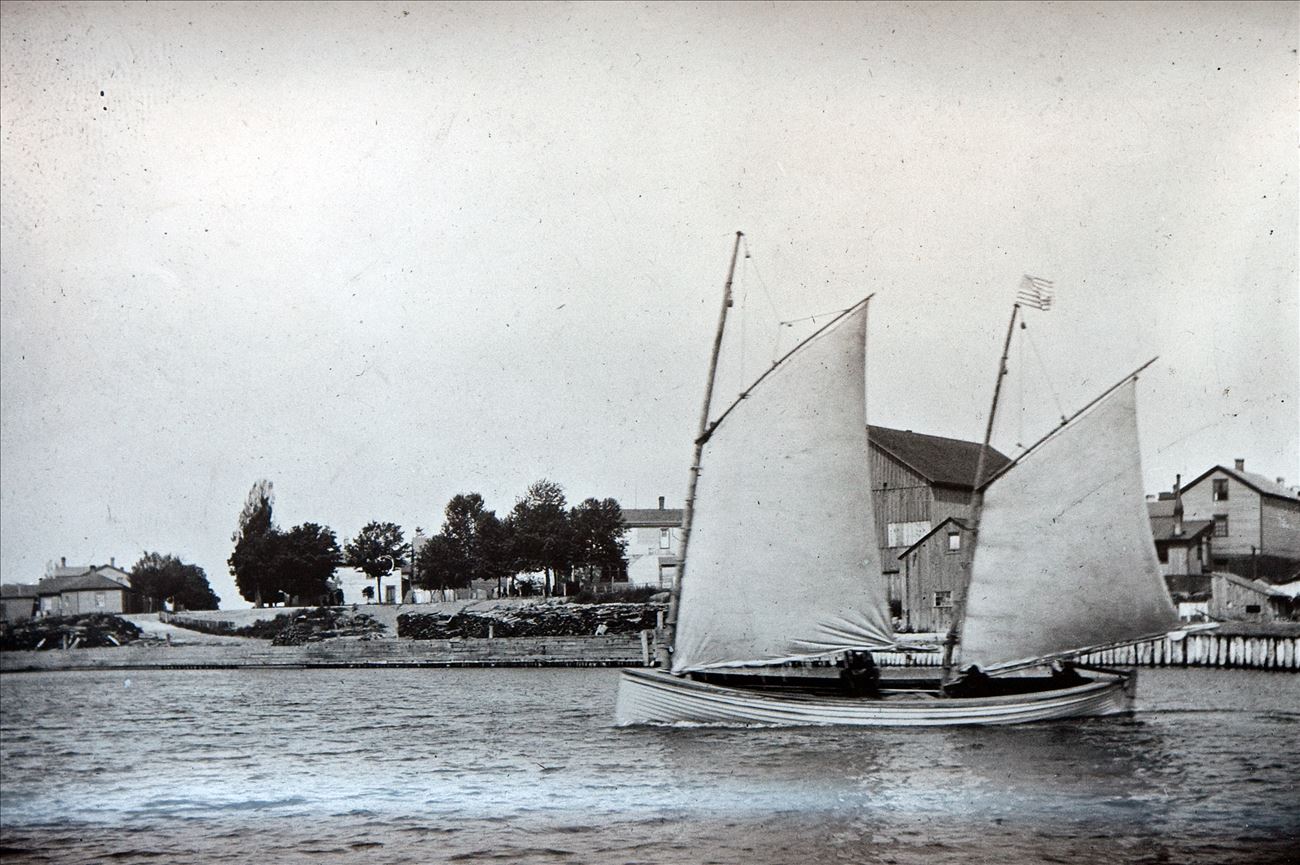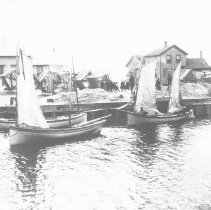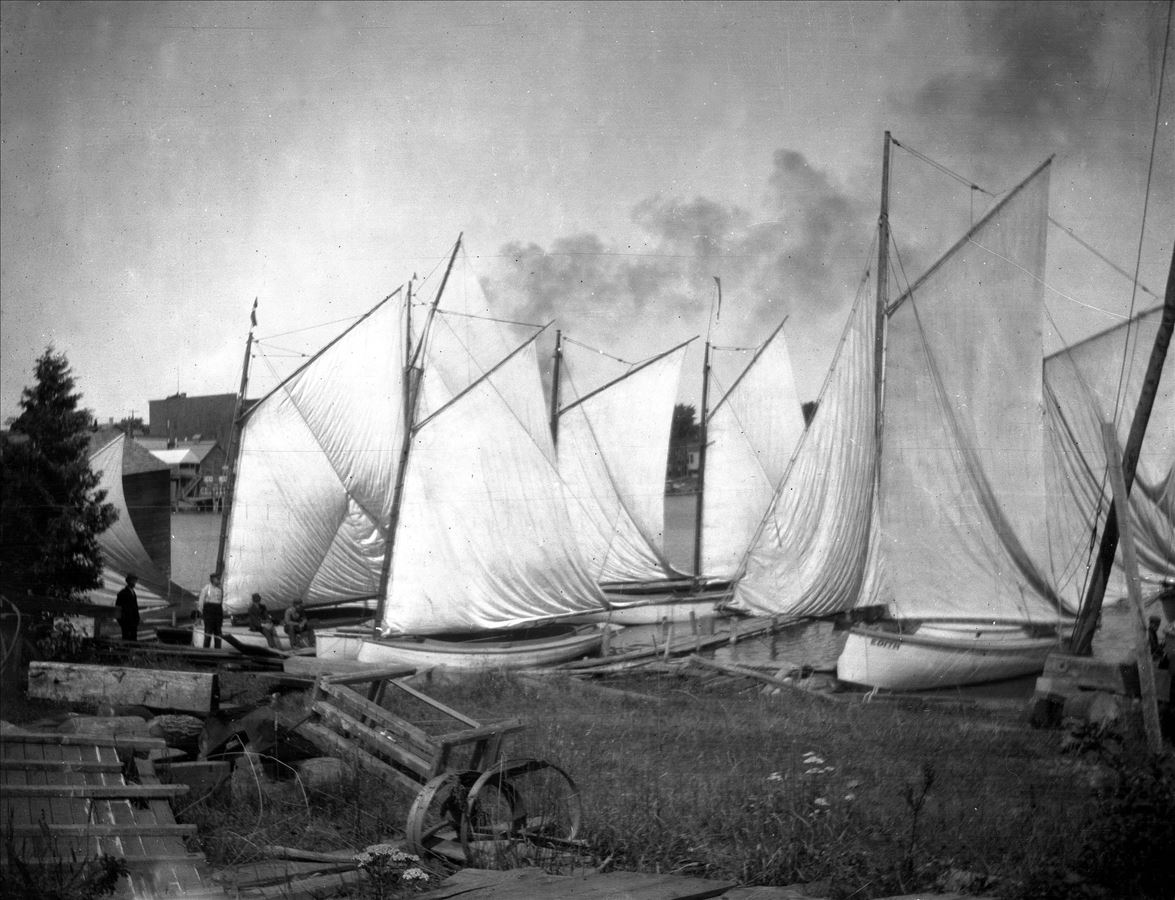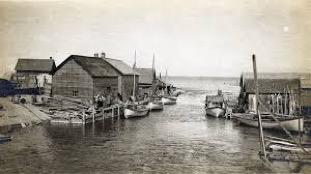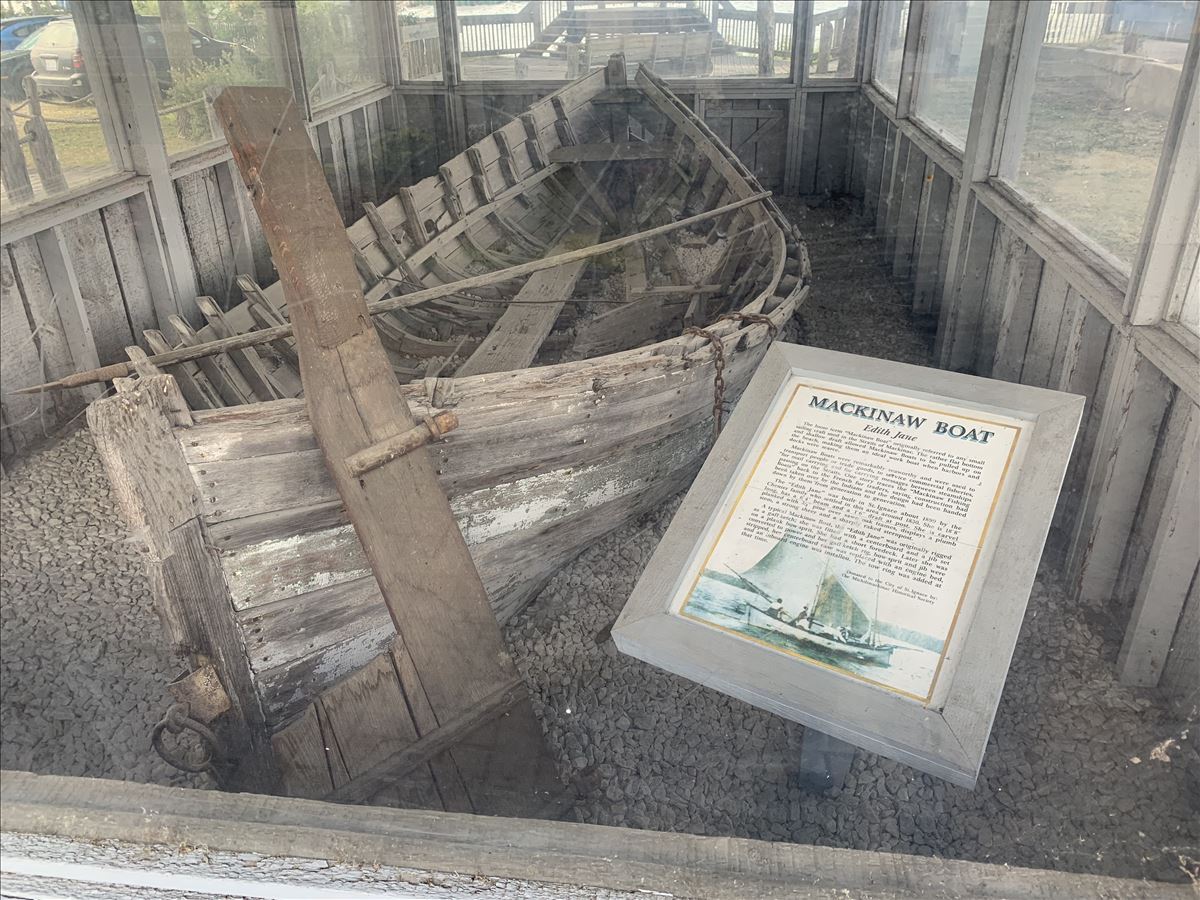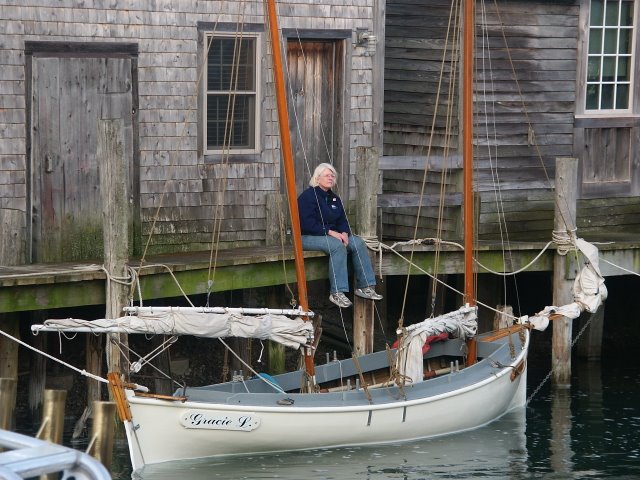A Historical Perspective
Explorers, travelers, traders, coastal residents, and fishermen across the upper Great Lakes region found Mackinaw boats seaworthy and useful working vessels in the in the late 18th and 19th century. For these qualities and wide-spread use, they are sometimes referred to as the “pick-up trucks” of their day. For their roles as the most important commercial fishing boat of the 19th century they are especially significant
Fishermen and their boats are interrelated: they are work partners. That relationship was especially important in the days when fishermen and their boats worked offshore in isolation and rescue from boat failure due to storm or accident proved unlikely. A dry boat provided a place of safety from immersion in the cold waters of the Great Lakes – a situation as life-threatening today as in in times past.
The Mackinaw boat proved its worth and esteemed role in the history of Great Lakes commercial fishing. James W. Milner in his 1872-1873 “Report U.S. Commissioner of Fish and Fisheries” wrote this tribute: "She . . .is fairly fast and the greatest surf-boat known, and with experienced boatman will ride out any storm, or if necessary beach with greater safety than any other boat. They have been longer and more extensively used on the upper lakes than any other boat with the less loss of life or accident.”
Journals, reports and other written accounts and historical photographs document the presence of Mackinaw boats in shoreline fishing communities and isolated shoreline fish camps throughout the upper Great Lakes. In the 1880 the port of Two Rivers, WI was reported to have the largest fleet of Mackinaw boats on the Lake. 1893, Captain Roy Ranger sailed through the Straits of Mackinaw and east to Detour and reported: “I saw 60 boats in the harbor, and about 40 of which were Mackinaw boats.
The Enigmatic Mackinaw Boat
Over the (at least) seven decades, Great Lakes maritime historians, archaeologist, boat builders and traditional boat aficionados have researched, debated, designed and written about Mackinaw boats. Unravelling the development of these vernacular watercraft is fascinating and continues. The exact origins of the Mackinaw boat are obscured over time. The ghosts of Anishinaabek birchbark canoes, French-Canadian bateaus, Norwegians faerings, and a variety of other seaworthy small craft from Eastern seaboard and northern Europe lurk in their designs.
Timothy Cochrane and Hawk Tolsen in their book “A Good Boat Speaks for Itself: Isle Royale Fishermen and their Boats” provide a general timeline for the development of Mackinaw boats. In the late 1700s the use of the name “Mackinaw” boat was given to any small sailing vessel used in the Mackinaw Straits area. By 1780, it was applied to double-ended sailing barges used in the fur trade. This same description followed this type of Mackinaw boat as it moved with the fur trade through rivers of the upper Midwest. By the 1839 the description referred to virtually all double-ended sail boats with round bottoms. By 1850 Mackinaws were ubiquitous on the Upper Great Lakes.
Famed marine historian Howard Chapelle studies and documented North American small craft. In his “American Small Sail Craft: Their Design, Development and Construction” he provides a description and the lines of the double-ended c. 1881 Mackinaw that was used on Lakes Michigan and Superior. It is this design that is frequently used as the model for contemporary versions.
For this discussion the Mackinaw boat of the western Upper Great Lakes is defined by the following characteristics illustrated in Chapelle‘s drawings: a carvel or lapstrake hull, half-decked, round-bilged, double-ender with a centerboard, plum stem, down-sprung bowsprit and raked sternpost. They were generally two-masted with gaff-rigged sails and a loose-footed jib. Commonly these Mackinaw boats were 25-35’ LOA with a 4’ draft (board down) and 8-foot beam.
Chapelle also recognized some variants. In Ontario’s Georgian Bay, Collingwood Skiffs built by William Watts were common on the bay by the mid-1800s. They were double-ended, clench-fastened hulls, with a plumb stem and somewhat raked stern post, fitted out with one or two spritsails. On larger boats he added a bowsprit and jib. A third variation was usually clench built and with raking bows and hollow garboards.
The Fisherman’s Mackinaw
Mackinaw boats were small enough to be affordable for the laboring man—which included fishermen. They were used for gill-netting a harvesting method that was successful with open boats and small crews. A fishermen’s most expensive investment wa usually his boat. In 1885 fishermen working off the north shore of Lake Michigan could acquire a sizable good boat for $175-$200 including sails. On the west shore of Lake Michigan Manitowoc, WI Berger Boat Company sold them for $120.
Mackinaw boats were often built by on the beach or in boat sheds without formal plans. Each builder drew upon his knowledge and experience with Mackinaw boats and other watercraft, intended use, local custom and used local materials. Others were built in quantity in commercial boat shops and their designs evolved to meet the needs of their customers. Regional forests and wetlands provided good boat-building material: rot-resistant white oak, tamarack, and cedar and flexible yet strong black spruce, white pine, and white ash On Ontario’s Manitoulin Island, skilled Odawa builders supplied Mackinaw boats for the Wikwemikong community of fishermen. All along the shore, other Anishinaabe fishermen built their own boats as did other fishermen. In other fishing communities, such as Two Rivers, WI local carpenters and workmen built the local fleet.
Some builder’s identities stand out. One of the few remaining Mackinaw Boats is the Edith Jane, on display in St. Ignace, MI. It was by built around 1890 by the Chenier family of boatbuilder. Hyacinth Chenier who immigrated to the Mackinaw Straits in 1830 was considered an established boatbuilder by 1845. His family continued the trade until 1948.
Further east, Jesse Wells Church built Mackinaw boats on Harbor Island (just north of Drummond) and up the St. Mary’s River on Sugar Island. Church was an experienced sailing master and pilot who traveled throughout the upper Great Lakes. Much to the delight of today’s historians, he also kept excellent records and journals from 1854 to 1892 that provide details of the boat built in his shops. Church’s Mackinaws reflect many features of the boats he saw on his travels.
In northwest lower Michigan well-traveled Captain Roy Ranger built Mackinaw boats in Charlevoix MI from around 1882 to 1910. It was said he could produce one in three to four weeks and sell it for $350 to $450.00
Further details are gleaned from written descriptions, and historic photographs or drawn from common uses of materials in larger sailing vessels of the time. Most historic photos show Mackinaw boats with white hulls with dark trim. Fasteners and other hardware were most likely iron. Halyards, sheets and shrouds (when they were used) other lines were hemp. Sails were cotton canvas, some preserved with tan-bark tea that colored them a red-brown. Wood fish boxes were used to carry nets to the fishing grounds and fill with the day’s catch. Gill nets were cotton or linen with cedar floats and stone or lead weights.
The sail rig was one that could be easily handled and maintained a low center of effort for stability. Thus, it could be handled by a small crew of fisherman. Often, they were rigged as practical two-masted schooners with a gaffed fore and main sail, and a loose-footed jib. Other rigs found in old photos included sloops and cat-ketches and cat-schooners (without bowsprits). Some had topsails.
Powered by strong shoulders and sturdy oars (some were 18’ long!) fishermen in Mackinaw boats could also travel to their fishing grounds or back home no matter the winds. Though Mackinaws had a shallow keel, a centerboard provided stability under sail. When the board was raised, the reduced draft allowed the fishermen to cross a shoal water or pull it up on the beach. Most carried a moveable ballast of rock.
The interior was built for a gill-netter’s operations. A partially-decked layout provided standing work space for the fishermen and compartments for separate ballast fish and net boxes. Some were fitted with compartments with moveable boards to protect the catch from the sun after they were caught. An extra sheet of canvas could be rigged for a spray cover. The open design provided easy access for setting and pulling nets. Washboards and high coamings prevented water from running into the boat. Gill-netters used hand-roller to pull nets. The Mackinaw boats seaworthy abilities allowed fishermen to work offshore in all kinds of weather and set miles of gill nets.
From Mackinaw Boat To?
The advent of the small internal combustion gas engine (c. 1905) spelled the transition of the off-shore commercial fishermen to powered watercraft. Some Mackinaws were motorized and an enclosed cabin added showing us the first of the upper Great Lakes “turtle back” fishtug. In early photographs of fishing villages like Leland, MI you can see the characteristics of the trusty Mackinaw boats in the first fish tugs moored in the Leland River.
Some of the old Mackinaws also became recreational sailboats. Early 20th century photographs also show folks in what looks to be casual resort clothing enjoying a sail. Captain Roy Ranger a prolific builder of Mackinaws began building them for Charlevoix resorters. His last Mackinaw Shoodle perhaps the last original Mackinaws afloat is still in use as the Chicago Club resort’s workboat.
The late 20th century saw a swell of appreciation for the Mackinaw’s as the historians other than Chapelle began the work of documenting the last the boats and gathering information on the them. Oliver A. Birge was one. As a child he had sailed on Wabesi a Mackinaw owned by Joseph Osogwin: sailor, fisherman and trader. The 26’ gaff-rigged schooner, built by the Cheniers in Mackinaw City, enjoyed a 70 year career on the lake. When Oliver moved to the Les Cheneaux Islands in the 1930s he took on the task of taking her lines and collecting her story thus preserving her legacy.
In more recent years Great Lakes maritime archaeologists including Hawk Tolsen, Ken Vrana and David Cooper have documented the architecture of Mackinaw boats from drawings, photographs and the remnants of Mackinaw boats both submerged and ashore. There are also thoughtful cultural histories of Mackinaw boats and fishermen who sailed them written by Pat Labadie, Tim Cochran and Tyvie Jensen. Comphrehensive articles that trace the evolution of the Mackinaw boats by Roger Swanson, Owen Cecil have been published in WoodenBoat Magazine. See the bibliography below for these resources.
Appropriately, two Mackinaw boats can be found in the Mackinaw Straits today . In 1900 Marine reporter and weatherman Charles Dagwell built himself a seaworthy Mackinaw boat for his work out on the often turbulent waters of the Mackinaw Straits. His 16’ lapstrake, fitted for rowing and sail, is preserved in the museum collection at Fort Michilimackinac State Historic Park. Across the Mackinaw Bridge, the c. 1899 the hull of the Edith Jane can be found in shelter in downtown St. Ignace, MI.
Visitors can see replica Mackinaw boats at maritime history organizations. These include the Michigan Maritime Museum (South Haven, MI), Wisconsin Maritime Museum (Manitowoc, WI). Other organization like the Maritime Heritage Alliance (Traverse City, MI), Grand Portage National Monument (Grand Portage, MN) and Heritage Coast Sailing & Rowing (East Tawas, MI) build, sail and row their Mackinaw boats. Find links to these organizations on this website.
Though the Mackinaw boat of the Upper Great Lakes was a practical utility vessel, there is no doubt the they were also beautiful in their practical application. Today we admire their place in Upper Great Lakes maritime history and visual beauty documented in the photographs that illustrate the graceful lines of the hull and wind-filled sails.
Sources & Suggested Reading
Books
Blamford Don. Freshwater Heritage: A History of Sail on the Great Lakes 1670 to 1918. Toronto, ON: National Heritage Books. 2007.
Bogue, Margaret Beattie. Fishing the Great Lakes: An Environmental History, 1873-1933. Madison, WI: University of Wisconsin Press. 2000.
Chapelle, Howard I. American Small Sail Craft: Their Design, Development and Construction. New York, NY: W.W. Norton & Company. 1951.
Cohrane, Timothy and Tolson, Hawk. A Good Boat Speaks for Itself: Ilse Royal Fishermen and Their Boats. Minneapolis, MN: University of Minnesota Press. 2003.
Jensen, Tryvie. Wooden Boats and Iron Men: History of Commercial Fishing in Northern Lake Michigan and Door County 1850-2005.” DePere, WI: Paisa Publishing Co. 2007.
Peters, Scott. Making Waves: Michigan’s Boat-Building Industry 1865-2000. Ann Abor, MI: University of Michigan Press. 2015
Smith, Hugh M. and Snell, Merwin-Marie, Complied by. Fisheries of the Great Lakes in 1885. U.S. Government Printing Office, 1891.
Articles & Documents
Cecil, Owen, “The Mackinaw Boat: It’s a barge, birchbark canoe, fishing sailboat and what else?” in Woodenboat Magazine. January/February 2001. 60-68.
Holmquist, June Drenning. “Commercial Fishing on Lake Superior in the 1890s.” in Minnesota History Magazine. Minnesota Historical Society. Summer 1955. 243-249.
Swanson, Roger. “Edith Jane: The Search for a Real Mackinaw Boat.” in Woodenboat Magazine. March/April. 1982. 100-106. [ON 7923]
Murphy, Mathew P. “A Mini Lake Michigan Workboat.” WoodenBoat Magazine’s 2008 Small Boats. 94-97.
On-Line Resources
“A Mackinaw Boat Returns to Lake Superior.” https://web.archive.org/web/20060617202920/https://www.nps.gov/grpo/mackinaw.htm. Accessed 9/14/2019. Accessed 9-12-2019.
Labadie, Pat, Argranat, Brina J. and Scott Anfinson, Scott. “History and Development of Great Lakes Water Craft” Adapted from the National Register's Multiple Property Documentation(MPDF) in Minnesota's Lake Superior Shipwrecks A.D. 1650-1945. Minnesota, MN. Minnesota Historical Society. No date. http://www.mnhs.org/places/nationalregister/shipwrecks/mpdf/mpdf2.php. Accessed 9-12-2019.
Meverden, Keith N. and Thomsen, Tamara L. “Small Boats on a Big Lake: Underwater Investigations of Wisconsin’s Trading Fleet 207-2009.” State Archaeological and Maritime Preservation Technical Report Series #10-001. Wisconsin Historical Society. 2010. http://www.wisconsinshipwrecks.org/Files/Small%20Boats%20on%20a%20Big%20Lake.pdfAccessed 9/13/2019.
Ramsey, Gordon. “Voyage of the Drontheim: From Greencastle Skiff to Mackinaw Boat.” Causeway Coast Martine Maritime Heritage Group. http://ccmhg.co.uk/background/voyage-drontheim. Accessed 9/19/2019.
Laura Quackenbush is a Upper Great Lakes maritime historian and interpreter who lives on and sails from the Michigan’s Leelanau Peninsula. She is a member of the Maritime Heritage Alliance based in Traverse City, MI.
What you can do here
Access Fishing History & Culture ResearchBoat Viewing
| Info | |||
|
The North Shore Folk School is campus of classrooms where traditional learning and cooperative learning is practiced.
| Info | ||
| Info | |||
|
Promoting Community Boat Building, Rowing & Sailing on the Heritage Coast of Michigan
| Info | ||
|
Boat displays
| Info | ||
|
View a historic Mackinaw Boat on display in St. Ignace.
| Info | ||
|
Fishing Museum
| Info | ||
|
Maritime Museum
| Info |
A book about Isle Royale (Michigan) Fisherman and Their Boats | Info | |
Book documenting fishing in the Great Lakes from 1783-1933 | Info | |
Mackinaw boats were an essential model of a vessel in the 19th century, such as the Helen Macleod. | Info | |
Mackinaw Boats were great for fishing either while rowing or sailing. | Info | |
Book presents history of commercial fishing in northern Lake Michigan and Door County 1850-2005. | Info |
Affiliated Organizations: Maritime Heritage Alliance, Heritage Coast Sailing & Rowing

